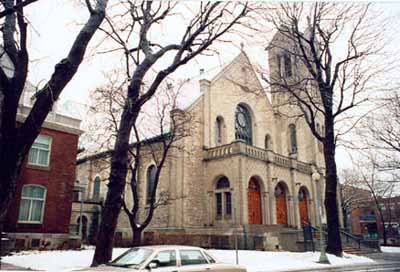Church of Saint-Léon-de-Westmount National Historic Site of Canada
Westmount, Quebec

General view
(© Parks Canada Agency / Agence Parcs Canada, Rhona Goodspeed, 1996)
Address :
4311 de Maisonneuve Boulevard West, Westmount, Quebec
Recognition Statute:
Historic Sites and Monuments Act (R.S.C., 1985, c. H-4)
Designation Date:
1997-09-22
Dates:
-
1901 to 1903
(Construction)
-
1928 to 1951
(Significant)
-
1920 to 1920
(Addition)
Event, Person, Organization:
-
Guido Nincheri (artist)
(Person)
-
Alphonse Monette
(Architect)
Other Name(s):
-
Church of Saint-Léon-de-Westmount
(Designation Name)
Research Report Number:
1997-004
Plaque(s)
Existing plaque: 4311 Maisonneuve Boulevard West, Montréal, Quebec
This splendid interior was designed by the prolific and talented Canadian artist Guido Nincheri (1885-1973). His wall paintings are an outstanding example of mural decoration, which was popular from the late 19th to the mid-20th century. Beginning in 1928, he executed these works in true fresco, a method of painting directly onto fresh plaster rarely used in Canada, but mastered by Nincheri in Italy where he was born and trained. In this church, Nincheri combined architecture, stained glass, painting and sculpture to create one of his most remarkable masterpieces.
Description of Historic Place
The Church of Saint-Léon-de-Westmount National Historic Site of Canada is located in Westmount on the island of Montréal. The church possesses a remarkable decorative program including frescoes, stained glass windows, stonework, woodcarving and bronzework, all conceived by the artist Guido Nincheri. Based on a Latin cross plan, this Romanesque Revival church features an Italianate façade with bell tower. Official recognition refers to the building, with its murals, on its footprint.
Heritage Value
The Church of Saint-Léon-de-Westmount was designated a national historic site of Canada because: it represents a superior example of mural decoration dating from the period (late 19th century to mid-20th century) when the use of mural painting was prevalent in Canada; the church’s paintings are one of the few known Canadian examples executed in the traditional wet-plaster “buon” fresco technique and they are the work of the prolific Guido Nincheri, the only identified artist in Canada who worked in the technique; the church is considered to contain the best example of a comprehensive interior decorative programme carried out by Nincheri, who executed the frescoes and designed all aspects of the ensemble.
The Church of Saint-Léon-de-Westmount features a splendid interior designed by the prolific and talented Canadian artist Guido Nincheri (1885-1973). His wall paintings are an outstanding example of mural decoration. Beginning in 1928, he executed these works in the wet-plaster “buon” fresco technique, a method of painting directly onto the fresh plaster rarely used in Canada, but mastered by Nincheri in Italy where he was born and trained. In this church, Nincheri combined architecture, stained glass, painting and sculpture to create one of his most remarkable masterpieces.
Source: Historic Sites and Monuments Board of Canada, Minutes, June 1997.
Character-Defining Elements
The key elements that contribute to the heritage character of this site include: the church’s sympathetic Romanesque Revival style with principal façade elaborated in the Italianate manner, regular placement of doors and windows, including the rose and lancet windows with stained glass by Guido Nincheri; the Latin cross plan which creates the interior volumes and surfaces that house the Italian Renaissance-influenced interior decorative scheme by Guido Nincheri, notably the murals painted in the “buon” fresco technique on all the vaults including the murals of the four chapels in their materials and iconography; the sympathetic interior decorations and furnishings designed by Nincheri and executed by Italian artist Guido Casini, including the pulpit, the baptistery, the churchwarden’s pew, the main altar, the altar rail, the pulpit, the two altars and two confessionals in the four small chapels, the marble chancel steps, the mosaics, and the marble wainscoting and paneling in their design and materials, the elaborate woodcarving by Alvieri Marchi including that on the main door, the choir stalls, the vestry, the confessional doors, the sanctuary doors, and the balustrade of the organ-loft in its design and original materials, and the fourteen stations of the cross sculpted in bronzework by Federico Sciortino in their original design and materials.